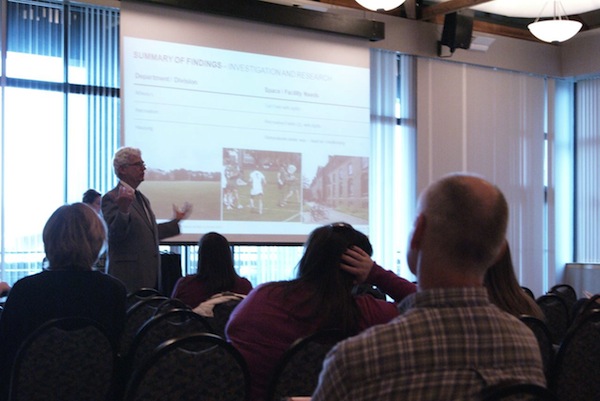When current students come back to the College of William and Mary for their 20th reunion, they may need to pick up a campus map to get around.
The College is planning to undertake widespread renovations within the next 10-20 years to address current issues around campus. These problems include the declining condition of many academic buildings and the lack of a centralized space devoted to student life.
Director of Planning, Design and Construction Wayne Boy said in an open meeting Thursday, Feb. 20 that the changes will emphasize the renovation of current facilities, and will minimize new construction.
“If it’s in the historic campus east of the Sadler Center, we’ll gut the building and renovate it because we’ve got an architecturally significant shell,” Boy said. “If it’s west of that area, my hope would be that we don’t build additional space, but we tear down the space of the 1960s south campus and replace it with something better.”
One of the first potential changes on campus will be the development of a new, three-building arts complex near Phi Beta Kappa Memorial Hall. The committee also aims to add a turf field with lights for athletics, two lighted recreational fields and air conditioning in residence halls.
A focus will also be put on student life and wellness. According to the committee’s current data, the Campus Center currently lacks 72,700 square feet of necessary space. The plan suggests constructing several new buildings near the Sadler Center to centralize and expand the hub of student life, rather than having it divided between the Sadler Center and the Campus Center.
“The thrust seems to be to move student life here [to the Sadler Center], not split it between the two centers,” Boy said.
After presenting the basic plan, the committee opened the floor for questions. Forum attendees expressed concerns about the lack of space in McGlothlin-Street Hall for the computer science department, mold and climate control problems in Washington Hall, deficiencies in campus safety — such as nighttime lighting and bike paths — and problems with parking services.
The committee conducted a parking study that indicated a need to address the location of parking spaces, not the quantity.
“We’re more or less in equilibrium between demand and supply; we just have a location issue,” Alan Resnick, AIA LEED AP and vice president of the Brailsford and Dunlavey program management firm, said.
Maggie Perreault ’15 voiced her concern for the current lack of administrative space devoted to wellness.
“Myself and some other students have been working with people in the Center of Student Diversity … about the importance of having health and wellness spaces designated on campus and how there’s a larger need for them and a larger need for more than the one room we have now to handle all those things,” Perreault said.
After the meeting, the audience was invited to give written feedback for the committee to use as it develops what it calls the “master plan.”
“A master plan is not a final document that sits on the shelf,” Reskin said. “We like to think of it as a framework for future decision-making, so it becomes a living document that serves in the right direction for the campus development, but we recognize that it would be modified over time based on the kinds of considerations and criteria the master plan describes.”

